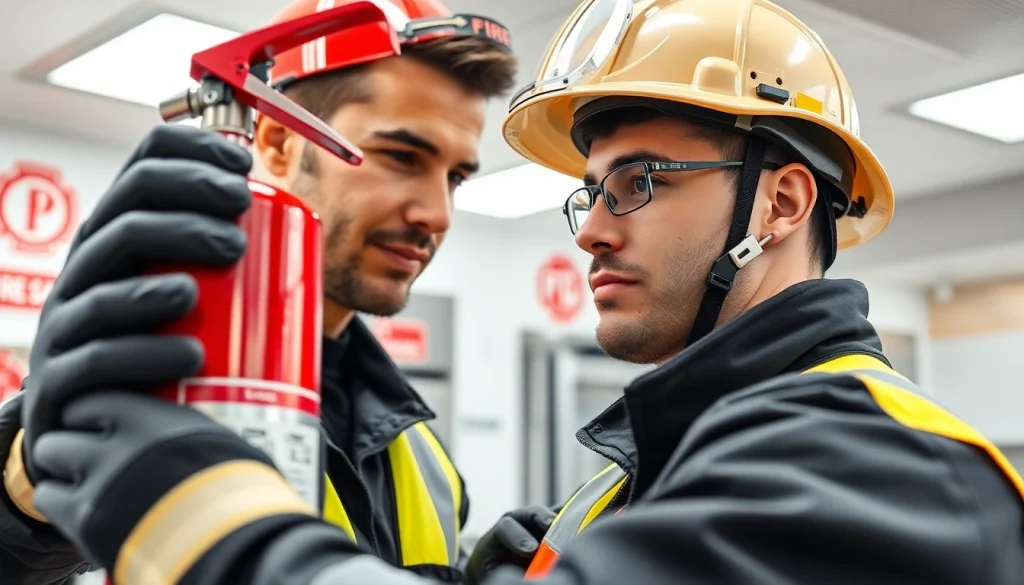Comprehensive Fire Extinguisher Service for Safety and Compliance

Understanding Fire Extinguisher Service
What is Fire Extinguisher Service?
Fire extinguisher service refers to a range of maintenance activities designed to keep fire extinguishers in optimal working condition. This includes inspecting, testing, and repairing fire extinguishers to ensure that they perform effectively in an emergency. Proper service and maintenance can significantly increase the lifespan of extinguishers and assure compliance with safety regulations.
Many businesses and organizations utilize professional fire extinguisher service providers to conduct inspections and maintenance activities, which often include visual inspections, hydrostatic testing, refilling, and replacement as necessary. Understanding the components of fire extinguisher service can help organizations maintain a safe environment and uphold their responsibilities to employees and stakeholders.
Importance of Regular Maintenance
Regular maintenance of fire extinguishers is critical for several reasons:
- Safety Assurance: Regular inspections help identify any malfunctions or issues that could render an extinguisher useless during a fire emergency. Failure to maintain extinguishers can lead to disastrous consequences.
- Compliance: Most regions have strict regulations regarding fire safety equipment. Regular servicing of fire extinguishers ensures compliance with local laws and ordinances, avoiding potential fines or liabilities.
- Operational Reliability: Consistent maintenance guarantees that fire extinguishers are always in working order, providing peace of mind to business owners, employees, and customers alike.
Regulatory Compliance and Inspections
Compliance with fire safety regulations is essential for any organization. The National Fire Protection Association (NFPA) establishes guidelines that dictate how often fire extinguishers must be inspected and maintained. Generally, fire extinguishers should be inspected monthly by a designated employee, while a licensed professional should conduct annual inspections. Additionally, fire extinguishers require a thorough inspection every six years and hydrostatic testing every 12 years.
Adhering to these regulations not only enhances safety but also protects businesses from legal liabilities. Establishments that neglect these responsibilities may face penalties or damage claims should an incident occur due to equipment failure. Thus, being proactive in maintaining fire safety standards is not merely a chore but a vital component of operational excellence.
Types of Fire Extinguishers and Their Maintenance
Common Types of Fire Extinguishers
Understanding the various types of fire extinguishers is crucial as each type is designed to tackle specific classes of fire:
- Water Extinguishers (Class A): Suitable for ordinary combustible materials such as wood and paper.
- Foam Extinguishers (Class A and B): Effective on flammable liquids like gasoline as well as solids.
- Dry Powder Extinguishers (Class A, B, C): Versatile extinguishers that can combat solid, liquid, and gas fires.
- CO2 Extinguishers (Class B and C): Ideal for electrical fires and flammable liquids.
- Wet Chemical Extinguishers (Class K): Designed specifically for kitchen fires involving cooking oils and fats.
Maintenance Procedures for Each Type
Different extinguishers require unique maintenance procedures:
- Visual Inspections: Conduct regular visual checks to ensure the extinguishers are easily accessible, clearly visible, and not obstructed.
- Pressure Checks: Ensure the pressure gauge is in the operable range. If not, the extinguisher needs to be refilled or recharged.
- Physical Condition: Look for any signs of damage or corrosion on the cylinder, nozzle, or other parts.
- Maintenance Tag Review: Ensure an up-to-date service tag is affixed, showing the last service date and next inspection due date.
- Recharging: If an extinguisher is used, it must be recharged immediately, regardless of how much was discharged.
Indicators of Extinguisher Issues
Identifying issues promptly can save lives and property. Key indicators include:
- Pressure gauge showing a reading outside the operable range.
- Dents, rust, or any visible signs of damage on the extinguisher.
- Missing or damaged safety seals or tamper indicators.
- Signs of leakage or corrosion at connections.
- Age of extinguisher, as most have a lifespan of 10-12 years.
Choosing a Fire Extinguisher Service Provider
What to Look For in a Service Provider
Choosing the right fire extinguisher service provider is imperative for maintaining the safety of your organization. Look for the following attributes:
- Certifications: Ensure that the provider has the necessary licenses and certifications from relevant authorities.
- Experience: An established service provider with years of experience can be invaluable in identifying issues and implementing effective solutions.
- Comprehensive Services: A good provider should offer a full suite of maintenance options, including inspections, recharges, repairs, and replacements.
- Customer Reviews: Researching online reviews and testimonials can offer deeper insights into the provider’s reputation and service quality.
Questions to Ask Before Hiring
Here are essential questions to ask any potential provider before commitment:
- What are your service rates, and do you offer package deals?
- How often should inspections and maintenance be performed according to your evaluation?
- Do you guarantee your services, and what is your policy on follow-ups and re-checks?
- Can I view documentation of compliance with local regulations and safety standards?
- What specific brands or types of extinguishers do you service and maintain?
Comparing Local Services Effectively
When selecting a local fire extinguisher service, create a comparison matrix that includes:
- Service offerings (e.g., inspection frequency, types of extinguishers serviced).
- Cost-effectiveness and scope of services provided.
- Turnaround times for service requests and emergency response capabilities.
- Client reviews and reputation within the community.
By evaluating multiple service providers against these criteria, you can make a more informed choice that best fits your organizational needs.
DIY Fire Extinguisher Checks: A Quick Guide
Essential Steps for Quick Inspections
For organizations without a dedicated maintenance team, conducting basic DIY checks can help maintain fire extinguishers:
- Check Pressure: Ensure the pressure gauge shows the appropriate range.
- Inspect for Damage: Look for physical signs of wear or damage on the extinguisher.
- Verify Accessibility: Ensure it is within reach and free from obstructions.
- Review the Maintenance Tag: Confirm that the service is up to date.
Signs That Require Professional Attention
If any of the following signs are detected during DIY inspections, professional service should be engaged immediately:
- Pressure gauge outside the operational range.
- Visible dents or corrosion.
- Loose components or damaged nozzles.
Safety Precautions During Inspections
During DIY checks, safety should always be a priority:
- Wear protective gear if necessary.
- Ensure the area is well-lit and free from hazards.
- Involve a colleague during inspections for added safety.
Maximizing the Effectiveness of Fire Extinguisher Service
Training Employees on Fire Safety
Employee training is a critical component of fire safety. Regular training sessions should cover:
- The correct use of fire extinguishers.
- Evacuation plans and designated assembly points.
- Basic fire awareness and prevention strategies.
By equipping employees with knowledge and skills, organizations can significantly enhance overall safety and preparedness.
Regular Drills and Practice
Incorporating routine fire drills into operational procedures reinforces learned skills and identifies areas for improvement. Frequency should be at least twice a year, ensuring all staff knows what to do in an emergency.
Staying Up-to-Date with Fire Safety Standards
Fire safety standards and regulations can change. Organizations must regularly stay informed about local regulations and industry practices, ensuring compliance and leveraging best practices that keep workplace safety at the forefront.







